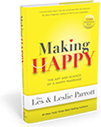I can be so all-or-nothing with prayer. I think I have to be in full monastic mode or praying for hours on end to do it “right,” and that makes me want to quit before I start. I wonder if I sat in the lotus position on a platform overlooking the ocean, complete calm on my face, for thirty days in a row, if I would finally feel like a prayer warrior. For now, my prayer life is more like peanut butter ChapStick.
“I don’t need ChapStick,” my son once explained to me.
“Come on, sweetie. Your lips are red and cracked. ChapStick will help you feel better.”
“No, Mom. I just keep a little peanut butter on my lips after I eat my toast. Then later I can smear it around with my tongue—and it tastes a lot better than ChapStick.”
I truly love spending time with God, but I don’t pray with enough discipline.
I also wish I could pray longer and be less distracted when I do. My prayer life works for me, but I’m not sure if I’m always doing it the best way. For all my scattered ineptitude, my conversations with God are still meaningful, still sweet. I don’t have to be a great talker. God is kind enough to carry the conversation even when I am awkward or shy. All I have to do is show up. There are a few things that I’ve learned make it easier for me to be present with God when I pray.
First, I am most present when I pray both spontaneously and by appointment.
I think about my husband and me and all the rich conversations we’ve had when we’ve scheduled a time and intentionally invested in one another. Yet my heart races when there are unexpected flowers on the counter or when he surprises me with soft kisses on my neck while I’m making dinner. Spontaneous moments are an overflow of the heart, and the scheduled moments help keep our hearts in the right place. If Mike and I didn’t have any scheduled time together—if we never looked ahead at our calendar and made sure connection time was part of the craziness—those spontaneous moments wouldn’t happen.
Spontaneous prayer is an important part of my day.
I let my heart overflow when I’m feeling thankful, or I notice beauty and easily slip into worship. I also let my heart spill over when I’m feeling stressed or insecure, and I take those feelings to God as well. The more present I am with my own thoughts and emotions, the easier it is for me to be present with God. Nothing kills my prayer life faster than running from what I’m feeling or numbing myself with TV, social media, or shopping.
Spontaneous prayer wouldn’t flow from my lips if I didn’t have time with God intentionally set aside. I’ve tried a few different rhythms, but right now I go with a first-word, /last-word approach. The first word or thought when I wake up is a prayer for the day ahead. The last word or thought of the night is a prayer from the day that has ended. This planned time frames my day in a way that helps me pay attention to God’s presence with me, and it lays the foundation for plenty of spontaneous interactions in between.
I have also found I am most present when I pray alone and with others.
My default approach to prayer is private and alone, my prayers only living as thoughts in my head. While prayer is a conversation between God and me— and there are many times it makes sense for prayer to be private— prayer has always had a communal aspect in Christian tradition. In the New Testament we see the church praying together and for one another every time they come together.
For two years I woke up at 5:30 in the morning every Tuesday, while it was still quite dark, to curl up on the couch with my blanket and my cellphone. My friends Dawn and Tasha also had young kids and jobs, and our morning times were jam-packed from the minute the first little eyelids opened. So we carved out the only time we had, in the quiet space before the sun came up, to pray together.
When we started our Tuesday-morning prayer time, we didn’t know that all three of us would move within two years or that Dawn would move out of state. As we prayed through our big decisions together, big things happened. All the worries we had buzzing in our brains became prayers. We watched God guide us, surprise us, and answer our prayers in different ways. Seeing God work clearly in one another’s lives made it easier to notice His presence in our own. We would see some prayers answered before the next phone call, and some were answered weeks or years later. We would remind each other, “We prayed for that!”
Praying with others is powerful.
Praying with others—sharing the true pain and longings of our heart— will help us see God.Click To TweetPraying with others—sharing the true pain and longings of our heart— will help us see God. We’ll see Him answer quickly or not very quickly, obviously or subtly. When we pray through the long waiting of some requests and the sweet celebration of others, we remember that a “no” right now may simply be a “not yet.” We learn not to fear the valleys in our own life because we have already walked through the shadows with one another. Our own experiences of God and life are just a drop in the ocean, but prayer is a way we can join in the experience of others. A way we can be as connected as water to the words and ways of God.
My time praying with Tasha and Dawn connected me so closely to them that we found ourselves texting one another and praying for each other constantly. Whenever my alert sounded, Mike mumbled under his breath, “I wonder who that is.”
Your spouse should come before friends.
One night he surprised me when he said, “Tasha and Dawn know more about you than I do.”
“Honey. c’mon. You’re busy all day at work. You don’t want me texting you during your meetings to tell you what I had for lunch.”
“Maybe I do sometimes.”
I knew that the intimacy with my prayer group was meeting my need for connection. I was less lonely than I had been in a long time. But I had never thought of intimacy with my girlfriends as a threat to my husband. I thought it might be a gift to him if I were less needy and not pouncing on him with news about my day as he walked in the door. It wasn’t. He and I had a great conversation, and we came to an agreement. Nothing had to change with my friends and me, but if anything important happened, he would be my first text or call.
This simple communication plan increased the intimacy in our marriage so effectively that we’ve been practicing it for years. It has even worked as a connection builder in my prayer life. If anything happens that registers high on my emotional scale or seems important, I pray first. God is my first “call,” then Mike, and then anyone else. This simple order of communication has reinforced my priorities of connection and helps me remember to pray in the moment before I react.
Taken from God’s Many Voices © 2018 by Liz Ditty, Used with permission by Worthy Books, an imprint of Worthy Publishing Group, a division of Worthy Media Inc., All Rights Reserved.
Liz Ditty is the author of God’s Many Voices: Learning to Listen, Expectant to Hear. She is a writer, speaker, and Spiritual Director who serves on the teaching team at WestGate church in San Jose, CA.
Get the Book













